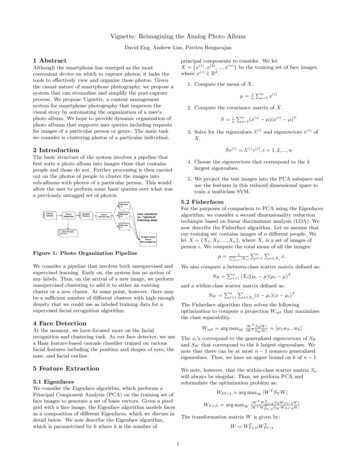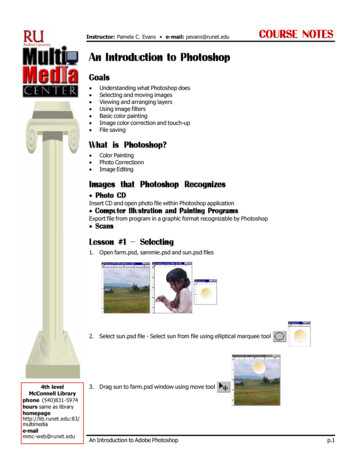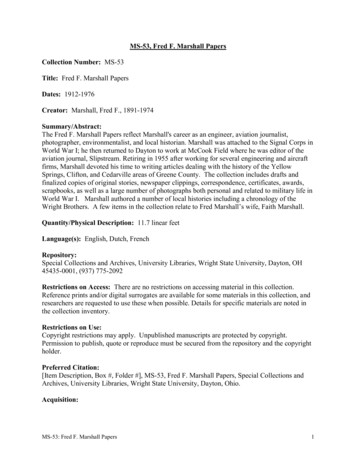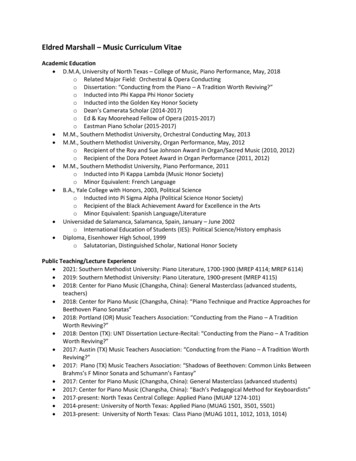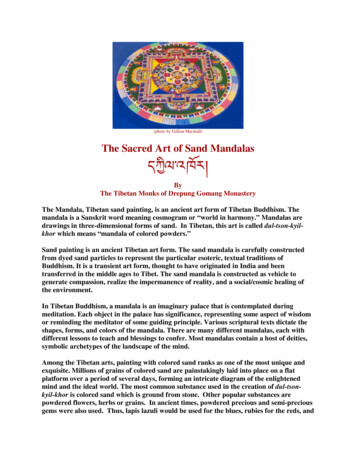
Transcription
(photo by Gillian Marshall)The Sacred Art of Sand MandalasByThe Tibetan Monks of Drepung Gomang MonasteryThe Mandala, Tibetan sand painting, is an ancient art form of Tibetan Buddhism. Themandala is a Sanskrit word meaning cosmogram or “world in harmony.” Mandalas aredrawings in three-dimensional forms of sand. In Tibetan, this art is called dul-tson-kyilkhor which means “mandala of colored powders.”Sand painting is an ancient Tibetan art form. The sand mandala is carefully constructedfrom dyed sand particles to represent the particular esoteric, textual traditions ofBuddhism. It is a transient art form, thought to have originated in India and beentransferred in the middle ages to Tibet. The sand mandala is constructed as vehicle togenerate compassion, realize the impermanence of reality, and a social/cosmic healing ofthe environment.In Tibetan Buddhism, a mandala is an imaginary palace that is contemplated duringmeditation. Each object in the palace has significance, representing some aspect of wisdomor reminding the meditator of some guiding principle. Various scriptural texts dictate theshapes, forms, and colors of the mandala. There are many different mandalas, each withdifferent lessons to teach and blessings to confer. Most mandalas contain a host of deities,symbolic archetypes of the landscape of the mind.Among the Tibetan arts, painting with colored sand ranks as one of the most unique andexquisite. Millions of grains of colored sand are painstakingly laid into place on a flatplatform over a period of several days, forming an intricate diagram of the enlightenedmind and the ideal world. The most common substance used in the creation of dul-tsonkyil-khor is colored sand which is ground from stone. Other popular substances arepowdered flowers, herbs or grains. In ancient times, powdered precious and semi-preciousgems were also used. Thus, lapis lazuli would be used for the blues, rubies for the reds, and
so forth. When finished, to symbolize the impermanence of all that exists, the coloredsands are swept up and poured into a nearby river or stream where the waters carry thehealing energies throughout the world.In general, all mandalas have outer, inner, and secret meaning. On the outer level theyrepresent the world in its divine form; on the inner level, they represent a map by whichthe ordinary human mind is transformed into the enlightened mind; and on the secretlevel, they predict the primordially perfect balance of the subtle energies of the body andthe clear light dimension of the mind. The creation of a sand painting is said to affectpurification and healing on these three levels.Every tantric system has its own mandala, and thus each one symbolizes an existential andspiritual approach. For example, that of Lord Avalokiteshvara symbolizes compassion as acentral focus of the spiritual experience; that of Lord Manjushri takes wisdom as thecentral focus; and that of Vajrapani emphasizes the need for courage and strength in thequest for sacred knowledge. Medicine Buddha mandalas are created to generate powers ofhealing.The creation of a sand mandala begins with an opening ceremony. Monks consecrate thesite and call forth the forces of goodness through chanting mantras accompanied by flutes,drums and cymbals. The construction of the mandala begins with the drawing of the designon the base, or tek-pu. The artists measure out and draw the architectural lines using astraight-edged ruler, compass and ink pen. The mandala is a formal geometric patternshowing the floor plan of a sacred mansion. Once the diagram is drawn, in the followingdays you see millions of grains of colored sand painstakingly laid into place. The sand,colored with vegetable dyes or opaque tempera, is poured onto the mandala platform witha narrow metal funnel called a "chakpur" which is scraped by another metal rod to causesufficient vibration for the grains of sand to trickle out of its end. The two "chakpurs" aresaid to symbolize the union of wisdom and compassion. The mandalas are createdwhenever a need for healing of the environment and living beings is felt. The monksconsider our present age to be one of great need in this respect, and therefore are creatingthese mandalas where requested throughout their world tours. When finished, to symbolizethe impermanence of all that exists, the colored sands are swept up and poured into anearby river or stream where the waters carry healing energies throughout the world.For information about and links for prints of the Medicine Buddha (healing) mandala,click here.For information about and links for prints of the Chenrezig (compassion) mandala, clickhere.For information about and links for prints about the Amitayus (long life) mandala, clickhere.
Mandala Construction Process1. Opening CeremonyThe monks begin by consecrating the site of the mandala Sand painting withapproximately 30 minutes of chants, music and mantra recitation. This event is visuallyand acoustically striking, and the media should be invited to attend.(photo by Gillian Marshall)Items needed for the Opening Ceremony:· Mandala Base· 5’x5’ plywood, no less than 1” thick and painted dark blue (this must beconstructed)· One table for Altar , Standard height, minimum length of 3ft· 2 bouquets of flowers· pitcher with water· 7 pieces of fruit: apples and/or oranges· 1 lb. of uncooked rice· 9 pillows and 1 comfortable chair
2. Drawing of the LinesAfter the Opening Ceremony the monks start drawing the line design for the mandala.This is very exacting work that takes about three hours to complete. It would be nice ifrefreshments such as soft drinks, hot milk tea, or juice was available for the monksthroughout the mandala construction.3. Mandala ConstructionThe monks will pour millions of grains of sand over a period of 4 to 5 days, usingtraditional metal funnels, called chak-pur. The finished Mandala is approximately 5 feet indiameter(photo by Gillian Marshall)
4. Mandala CompletionThe monks conclude their creation of the mandala with its consecration. In some cities,several thousand guests have attended the closing ceremony. It is very colorful and shouldbe considered a media event.5. Dismantling the MandalaDuring the Closing Ceremony, the monks dismantle the mandala, sweeping up the coloredsands to symbolize the impermanence of all that exists. Half of the sand may be distributedto the audience in small bags as blessings for personal health and healing.(photo by Gillian Marshall)Items needed for the Closing Ceremony:· bowl(s) and spoon(s) to distribute the sand· small zip lock bags or small envelopes for sand distribution· 2 bouquets of flowers· 7 pieces of fruit: apples and/or oranges
6. Dispersal of the sand(photo by Gillian Marshall)The monks, along with spectators, travel to a body of water. The sand is then ceremoniallypoured into the water in order to spread the healing energies of the mandala throughoutthe world.(photo by Gillian Marshall)
The Tibetan Monks of Drepung Gomang Monastery The Mandala, Tibetan sand painting, is an ancient art form of Tibetan Buddhism. The mandala is a Sanskrit word meaning cosmogram or “world in harmony.” Mandalas are . the clear light dimension of th


